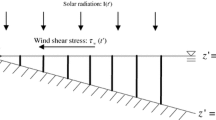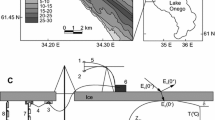Abstract
The fate of inflows into lakes has been extensively studied during summer stratification but has seen relatively little focus during the weak winter stratification, with or without ice-cover. Field observations are presented of groundwater inflow into a shallow bay of a subarctic lake. Atmospheric forcing of the bay during the study period was extremely variable and coincided with spring ice-cover break-up. Two dominant wind regimes were identified; (1) weak wind-forcing (wind speed <5 m s−1 or land-fast ice-cover), and (2) strong wind-forcing (wind speed >5 m s−1 and open water). At a relatively constant temperature of ~3.3°C, the groundwater inflow was closer to the temperature of maximum density than the water in the main body of the lake, which during the observed winter stratification is ~1.2°C. During weak wind-forcing, the stratification within Silfra Bay approximated two-layers as this denser groundwater formed a negatively buoyant underflow. A calculated underflow entrainment rate of 2.8 × 10−3 agrees well with other underflow studies. During strong wind-forcing, the water column out to the mouth of the bay became weakly stratified as the underflow was entrained vertically by wind-stirring. Observed periods of mixing can be predicted to occur when turbulent kinetic energy (TKE) production by wind stirring integrated over the underflow hydraulic residence time in the bay exceeds the potential energy associated with the stratification. A decrease of ice cover, as observed in the studied subarctic lake over the last decade, will result in the underflow being more frequently exposed to the strong wind-forcing regime during winter, thereby altering the winter distribution of groundwater inflow within the lake.










Similar content being viewed by others
References
Adalsteinsson H, Jónasson PM, Rist S (1992) Physical characteristics of Thingvallavatn. Oikos 64:121–135
Andradottir HO, Forrest AL, Laval BE (2009) Fate of groundwater inflow in Lake Tingvallavatn during early spring ice-breakup. 13th Workshop on Physical Processes in Natural Waters, Palermo, Italy: 1–4 September, 2009
Bengtsson L (1986) Dispersion in ice-covered lakes. Nordic Hydrol 17:151–170
Britter RE, Linden PF (1980) The motion of a front of a gravity current traveling down an incline. J Fluid Mech 99(3):531–543
Carmack EC, Gray CBJ, Pharo CH, Daley RJ (1979) Importance of lake-river interaction on seasonal patterns in the general circulation of Kamloops Lake, British Columbia. Limnol Oceano 24(4):634–644
Cenedese C, Whitehead WA, Ascarelli TA, Ohiwa M (2003) A dense current flowing down a sloping bottom in a rotating fluid. J Phys Oceano 34:188–203
Dallimore CJ, Imberger J, Ishikawa T (2001) Entrainment and turbulence in saline underflow in Lake Ogawara. J Hydr Engrg 127(11):937–948
Doble MJ, Forrest AL, Wadhams P, Laval BE (2009) Through-ice AUV deployment: operational and technical experience from two seasons of Arctic fieldwork. Cold Reg Sci Tech 56:90–97
Ellison TH, Turner JS (1959) Turbulent entrainment in stratified flows. J Fluid Mech 6:423–448
Farmer DM (1975) Penetrative convection in the absence of mean shear. QJR Meteorol Soc 101:869–891
Fer I, Lemmin U, Thorpe SA (2002) Contribution of entrainment and vertical plumes to the winter cascading of cold shelf waters in a deep lake. Limnol Oceanogr 47:576–580
Findikakis AN, Law AWK (1999) Wind mixing in temperature simulations for lakes and reservoirs. J Env Eng 125(5):420–428
Fischer HB, Smith RD (1983) Observations of transport to surface waters from a plunging inflow to Lake Mead. Limnol Oceanogr 28(2):258–272
Hauenstein W, Dracos TH (1984) Investigation of plunging density currents generated by inflows in lakes. J Hydraul Res 22:157–179
Heikinheimo M, Kangas M, Tourula T, Venäläinen A, Tattari S (1999) Momentum and heat fluxes over lakes Tämnaren and Raksjö determined by the bulk-aerodynamic and eddy-correlation methods. Agric For Meteorol 98–99:521–534
Imberger J, Parker G (1985) Mixed layer dynamics in a lake exposed to a spatially variable wind field. Limnol Oceanogr 30(3):473–488
Jakkila J, Leppäranta M, Kawamura T, Shirasawa K, Salonen K (2009) Radiation transfer and heat budget during the ice season in Lake Pääjärvi, Finland. Aquat Ecol 43:681–692
Kelley D (1997) Convection in ice-covered lakes: effects on algal suspension. J Plankton Res 19:1859–1880
Launiainen J (1995) Derivation of the relationship between the Obukhov stability parameter and the bulk Richardson number for flux-profile studies. Bound-Lay Meteorol 76:165–179
Launiainen J, Cheng B (1998) Modelling of ice thermodynamics in natural water bodies. Cold Reg Sci Technol 27:153–178
Lindegaard C (1992) Zoobenthos ecology of Thingvallavatn: vertical distribution, abundance, population dynamics and production. Oikos 64:257–304
MacIntyre S, Flynn KM, Jellison R, Romero JR (1999) Boundary mixing and nutrient fluxes in Mono Lake, California. Limnol Oceanogr 44(3):512–529
Miller LG, Aiken GR (1996) Effects of glacial meltwater inflows and moat freezing on mixing in an ice-covered Antarctic lake as interpreted from stable isotope and tritium distributions. Limnol Oceanogr 41(5):966–976
Morillo S, Imberger J, Antenucci J, Woods PF (2008) Influence of wind and lake morphometry on the interaction between two rivers entering a stratified lake. J Hydr Engrg 134(11):1579–1589
Papaioannou G, Papanikolaou N, Retalis D (1993) Relationships of photosynthetically active radiation and shortwave radiation. Theor Appl Climatol 48:23–27
Rueda FJ, MacIntyre S (2010) Modelling the fate and transport of negatively buoyant storm-river water in small multi-basin lakes. Env Model Softw 25:146–157
Simpson JE (1997) Gravity currents in the environment and in the laboratory, 2nd edn. Cambridge University Press, Cambridge
Stefanovic DL, Stefan HG (2002) Two-dimensional temperature and dissolved oxygen dynamics in the littoral region of an ice-covered lake. Cold Reg Sci Techol 34:159–178
Sveinbjornsson E (2009) Vetrarís á Þingvallavatni–gagnlegur veðurfarsmælir (e. Ice cover on Lake Thingvallavatn–practical weather monitoring). Náttúrufræðingurinn 78(1–2):66–76
Tucker WA, Green AW (1977) A time-dependent model of the lake-averaged vertical temperature distribution of lakes. Limnol Oceanogr 22:687–699
Vatnaskil Consulting Engineers (2000) Þingvallavatn. Rennslislíkan. Unnið fyrir Landsvirkjun og Orkuveitu Reykjavíkur. (e. Lake Thingvallavatn. Hydrological flow model. Produced for the National Power Company and Reykjavik Energy). Report no. 00.02, pp 78
Wells MG, Wettlaufer JS (2007) The long-term circulation driven by density currents in a two-layer stratified basin. J Fluid Mech 572:37–58
Weyhenmeyer GA, Meili M, Livingstone DM (2004) Nonlinear temperature response of lake ice break-up. Geophys Res Lett 31:L07203
Acknowledgments
This project was funded by the Canadian Northern Scientific Training Program (NSTP) and the University of Iceland Research Fund. Alexander Forrest was supported by a Canadian Natural Sciences and Engineering Research Council (NSERC) postgraduate scholarship-doctorate (PGS-D) scholarship. Thingvellir National Park rangers Einar Saemundsen and Scott Riddell are thanked for their assistance and continuous watching over the project. The efforts of our field crew working at times in difficult weather conditions, that is Pasquale Amendola, David Chretien, Lukas Eggler, Matthieu Fillon, Anna Lefering, Marie Mortamet, and Gudbjorg Esther Vollertsen, are greatly appreciated. The Institute of Biology at the University of Iceland and Finnur Ingimarsson at the Natural History Museum of Kopavogur are thanked for the loan of a boat during the field study. Teledyne Gavia, the manufacturer of UBC-Gavia, and specifically Richard Yeo and Eggert Magnusson, receive special thanks for their continuous help in these efforts. Icelandic Meteorological Office is thanked for providing reference weather data for the study. Sveinn Oli Palmarsson and Einar Sveinbjornsson are thanked for their sharing of information on the inflows and ice cover of Lake Thingvallavatn.
Author information
Authors and Affiliations
Corresponding author
Rights and permissions
About this article
Cite this article
Forrest, A.L., Andradóttir, H.Ó. & Laval, B.E. Preconditioning of an underflow during ice-breakup in a subarctic lake. Aquat Sci 74, 361–374 (2012). https://doi.org/10.1007/s00027-011-0227-2
Received:
Accepted:
Published:
Issue Date:
DOI: https://doi.org/10.1007/s00027-011-0227-2




